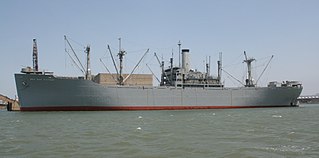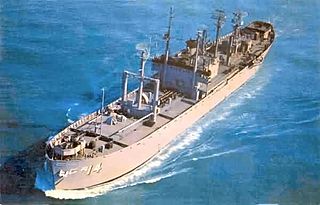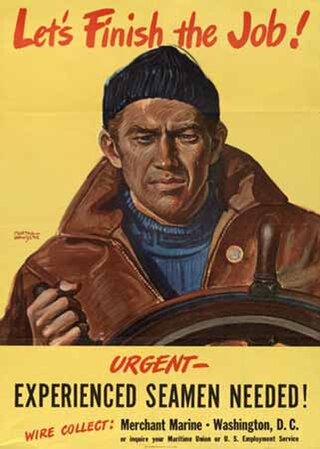
Seagoing cowboys is a term used for men and ships used from 1945 to 1947 for United Nations Relief and Rehabilitation Administration and the Brethren Service Committee of the Church of the Brethren that sent livestock to war-torn countries. These seagoing cowboys made about 360 trips on 73 different ships. Most of the ships were converted World War II cargo ships with added cages and horse stalls. The Heifers for Relief project was started by the Church of the Brethren in 1942; in 1953 this became Heifer International. In the wake of the destruction caused by the Second World War, the historical peace churches in the United States sponsored relief missions to war-ravaged Europe, typically in cooperation with the United Nations Relief and Rehabilitation Administration (UNRRA). These relief missions usually took the form of transporting farm animals, by transatlantic ship, to Poland and other countries where much of the livestock had been killed in the war. The men who tended the animals aboard these boats were called seagoing cowboys. These ships moved horses, heifers, and mules as well as chicks, rabbits, and goats. Ten seagoing cowboys died on the SS Park Victory when it sank after accidental grounding in the Gulf of Finland on December 25, 1947.

USNS Bowditch (T-AGS-21) was the lead ship of her class of oceanographic survey ships for the United States Navy. Launched as the SS South Bend Victory in 1945, Maritime Commission hull number MCV 694, a type VC2-S-AP3 Victory ship, she was named for Nathaniel Bowditch, the second U.S. Navy vessel named in his honor. The ship was acquired by the Navy in August 1957 and converted to an AGS at Charleston Naval Shipyard. Named Bowditch on 8 August 1957 and placed in service 8 October 1958 for operation by the Military Sea Transportation Service (MSTS).

USS Georgetown (AGTR-2/AG-165), was an Oxford-class technical research ship acquired by the U.S. Navy to provide a seaborne platform for global eavesdropping on behalf of the National Security Agency. Her designation as a "technical research" ship was her cover story.

USS Skywatcher (YAGR/AGR-3) was a Guardian-class radar picket ship, converted from a Liberty Ship, acquired by the US Navy in 1954. She was converted into a radar picket ship and assigned to radar picket duty in the North Atlantic Ocean as part of the Distant Early Warning Line.

USS Interpreter (AGR-14) was a Guardian-class radar picket ship, converted from a Liberty Ship, acquired by the US Navy in 1957. She was reconfigured as a radar picket ship and assigned to radar picket duty in the North Pacific Ocean as part of the Distant Early Warning Line.

USS Boulder Victory (AK-227) was a Boulder Victory-class cargo ship acquired by the US Navy during World War II. She was the lead ship of 20 ships in her class. She carried ammunition into the Pacific Ocean war zone and, on 20 December 1944 at Manus Island, New Guinea, she struck a naval mine and suffered a very large hole in her side.

The SS Lindenwood Victory was a Victory-class cargo ship built during World War II. The Lindenwood Victory was a type VC2-S-AP2 victory ship built by Permanente Metals Corporation, Yard 2, of Richmond, California. The Maritime Administration cargo ship was the 766th ship built. Her keel was laid on May 12, 1945. SS Lindenwood Victory was an armed cargo ship She was built in just 70 days, under the Emergency Shipbuilding program for World War II. SS Lindenwood Victory was an armed cargo ship, named for Lindenwood University in St. Charles, Missouri, one of 150 educational institutions that had Victory ships named after them. The 10,600-ton ship was constructed for the Maritime Commission.

The SS Park Victory was a Victory-class cargo ship built during World War II under the Emergency Shipbuilding program. The ship was operated by the Seas Shipping Company. The ship launched on April 21, 1945, near the end of the war.

SS Mercer Victory was a Boulder Victory-class cargo ship built for World War II. Mercer Victory, a Victory ship, was launched 14 March 1945 by Permanente Metals Corporation, Richmond, California and operated by the States Marine Line. At the ceremonial ship launching, Mercer University President Spright Dowell said the SS Mercer Victory should strive: “to do her full-part for the national defense” and “to study a plan for after war conditions and needs.”

USS Alcor, AK-259, was a Greenville Victory-class cargo ship in service with the United States Navy from 1952 to 1968. She was originally built in 1944 as SS Rockland Victory, a World War II era Victory ship. She was sold for scrap in 1970.

The SS Carroll Victory was the twenty-seventh Victory ship built during the World War II under the Emergency Shipbuilding program. shewas launched by the California Shipbuilding Company on June 13, 1944, and completed on August 31, 1944. The ship was named after Carroll, Iowa. The ship’s United States Maritime Commission designation was VC2-S-AP3 with a hull number 27 (V-27). shewas operated by the Lykes Brothers Steamship Company and sheserved in the Atlantic Ocean during World War II. The Carroll was one of the new 10,500-ton class ship known as Victory ships that were designed to replace the earlier Liberty Ships. Unlike Liberty ships, Victory ships were designed to last longer and serve the US Navy after the war. The Victory ships differed from Liberty ships in that they were faster, longer and wider, taller, had a thinner stack set farther toward the superstructure, and had a long raised forecastle.

SS Cedar Rapids Victory was the 77th Victory ship built during World War II under the Emergency Shipbuilding program. She was launched by the California Shipbuilding Company on January 14, 1945, and completed on February 17, 1945. The ship’s United States Maritime Commission designation was VC2-S-AP3 and her hull number was 77. Her operator was the American West African Line.

The SS Gainesville Victory was the 22nd Victory ship built during World War II under the Emergency Shipbuilding program. She was launched by the California Shipbuilding Company on June 9, 1944, and completed on July 22, 1944. The ship’s United States Maritime Commission designation was VC2-S-AP3, hull number 22 (V-22). She was operated by the Seas Shipping Company. SS Gainesville Victory served in the Pacific Ocean during World War II. SS Gainesville Victory was number one of the new 10,500-ton class of ships, known as Victory ships. Victory ships were designed to replace the earlier Liberty Ships. Liberty ships were designed to be used just for WW2, while Victory ships were designed to last longer and serve the US Navy after the war. The Victory ships differed from the Liberty ships in that they were faster, longer, wider, taller, had a thinner stack set farther toward the superstructure, and had a long raised forecastle.

SS Frontenac Victory was a Victory ship built for the United States War Shipping Administration late in World War II under the Emergency Shipbuilding program. It saw service in the European Theater of Operations in the Atlantic Ocean during 1945, and in the immediate post-war period. SS Frontenac Victory was part of the series of Victory ships named after cities; this particular ship was named after the city of Frontenac, Missouri. It was a type VC2-S-AP2/WSAT cargo ship with the U.S. Maritime Commission (MARCOM), "Victory" (MCV) hull number 625, shipyard number 1597, and built by Bethlehem Shipbuilding Corporation in Baltimore, Maryland.

The SS Bucknell Victory was a Victory-class cargo ship built during World War II. The Bucknell Victory was a type VC2-S-AP2 victory ship built by Permanente Metals Corporation, Yard 2, of Richmond, California. The Maritime Administration cargo ship was the 728th ship built. Her keel was laid on December 27, 1944. SS Bucknell Victory was an armed cargo ship, named for Bucknell University in Pennsylvania, one of 150 educational institutions that had Victory ships named after them. She was built in just 70 days, under the Emergency Shipbuilding program for World War II. The 10,600-ton ship was constructed for the Maritime Commission.

SS Attleboro Victory was a Victory ship built for the War Shipping Administration late in World War II under the Emergency Shipbuilding program. It saw service in the European Theater of Operations in the Atlantic Ocean during 1945, and in the immediate post-war period. Attleboro Victory was part of the series of Victory ships named after famous cities. This particular ship was named after the city of Attleboro, Massachusetts. It was a type VC2-S-AP2/WSAT cargo ship with the United States Maritime Commission (MCV) -"Victory"; hull number 642, shipyard number 1597 and built by Bethlehem Shipbuilding Corporation in Baltimore, Maryland. Phyllis O'Neil of Attleboro, Massachusetts christened Attleboro Victory with a champagne bottle.

The SS Saginaw Victory was a Victory ship built during World War II under the Emergency Shipbuilding program. It was laid down and launched by the Oregon Shipbuilding Corporation, and completed on February 9, 1945. The ship's United States Maritime Commission designation was VC2-S-AP3 and hull number 152. The Maritime Commission turned it over for merchant navy operation to a civilian contractor, the Pacific-Atlantic Steamship Company under the United States Merchant Marine act for the War Shipping Administration. She was named after Saginaw, Michigan. Victory ships were designed to supersede the earlier Liberty ships. Unlike Liberty ships, Victory ships were designed to serve the US Navy after the war and to last longer. Compared to Liberty ships, Victory ships were faster, longer, wider, taller, and had a thinner stack which was set further forward on the superstructure. They also had a long, raised forecastle.

The SS Pierre Victory was a Victory ship built during World War II under the Emergency Shipbuilding program. It was laid down and launched by the Oregon Shipbuilding Corporation, and completed on February 5, 1945. The ship's United States Maritime Commission designation was VC2-S-AP3 and hull number 150. The Maritime Commission turned it over for merchant navy operation to a civilian contractor, the United States Lines under the United States Merchant Marine act for the War Shipping Administration. She was named after Pierre, South Dakota, the capital of the US state of South Dakota. The sponsor and christening of the SS Pierre Victory on Dec. 6, 1944 was Mrs. Emma S. Jassmann of Pierre, she had five sons who served during World War II,. The city of Pierre and the Pierre Chamber of Commerce sent Mrs. Jassmann to Oregon. The Mayor of City of Pierre, John B. Griffin, was also at the christening with other Pierre residents. She was built in only 98 days. Victory ships were designed to supersede the earlier Liberty ships. Unlike Liberty ships, Victory ships were designed to serve the US Navy after the war and to last longer. Compared to Liberty ships, Victory ships were faster, longer, wider, taller, and had a thinner stack which was set further forward on the superstructure. They also had a long, raised forecastle. SS Pierre Victory survived three separate kamikaze attacks by the Japanese in 1945.

USNS Norwalk (T-AK-279) was the first in her class, a Fleet Ballistic Missile Cargo Ship, which was launched as a World War II commercial Victory cargo ship SS Norwalk Victory under the Emergency Shipbuilding program. The Norwalk Victory was acquired by the U.S. Navy in 1963.

World War II United States Merchant Navy was the largest civilian Navy in the world, which operated during World War II. With the United States fighting a world war in all the world oceans, the demand for cargo and fuel was very high. Cargo and fuel was needed around the world for the United States Navy, United States Army, United States Marine Corps, United States Army Air Forces, United States Coast Guard and the support of the allied nations of the United States. American steamship companies chartered ships from the Maritime Commission and War Shipping Administration to meet the demand. Many United States Merchant Marine ships were newly built in the Emergency Shipbuilding Program, other ships were older World War I ships that were put back in service, or private ships acquired under Emergency war requisitions. The Merchant Navy operated in the Pacific War and European war. Over 200 US Merchant ships took part in the D-day Normandy landings. To make a Normandy breakwater Harbor, called Mulberry harbour, 33 merchant ships were sunk 1,000 yards from shore. Some of the ghosts merchant ships used were damaged and others were deemed too old.












